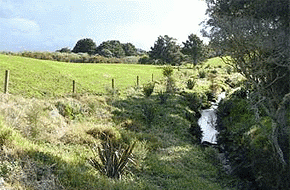
Content supplied by Fonterra
With Fonterra’s self-imposed deadline to have farm waterways fenced only two weeks away, the Co-operative’s farmers have dug, hammered and tensioned their way through 20,400 kilometres of fencing to exclude stock from waterways.
Fonterra’s Chief Executive Officer Theo Spierings says the numbers are fast gathering pace and by 1 December, it is expected that over 90 per cent of waterways will have stock exclusion in place, which is one of the most effective ways of contributing to better water quality.
“In total, our farmers will fence 24,400 kilometres of waterways which means another 4,000 kilometres to go. We can be very proud of our Co-operative and farmers as it has been a huge amount of effort to get to where we are today. Every kilometre completed is added protection for waterways and contributes to clean and green New Zealand," said Mr Spierings.
“Of the 4,000 kilometres left, some of it will already be fenced and it is a case of our team visiting the farm to verify that the work has been done. This takes time but means our data is accurate and robust."
“The remaining waterways to be fenced are the tough stuff. In many cases, it’s terrain that can be hard to access but we all remain committed to having 100 per cent of waterways with stock exclusion in place. It’s been a massive effort especially given we’ve had farmers who have gone back to square one after having fencing knocked out by floods or storms."
Outside of the Taranaki region, where the regional council already has a programme in place to exclude stock from waterways, Fonterra has mapped all farms. The mapping shows every waterway and fence and, by going farm-to-farm, the Co-operative has a clear picture of stock exclusion, while farmers also have clarity around which waterways needed fencing.
Mr Spierings said Fonterra is committed to providing its farmers with the guidance and support they need to lift their environmental performance and reduce their impact on waterways.
“Our Supply Fonterra programme makes that commitment real. It provides clarity around our requirements and offers support programmes on fencing, effluent management and nitrogen management. The programme is creating real change, and will continue to do so."
“We share New Zealanders concerns about water quality and we recognise that we must continue to up our game in the area of environmental sustainability. This is not just about dairy, but about New Zealand’s international reputation,” said Mr Spierings.
The Co-operative and its farmers are stewards of the land and each year Fonterra visits all 10,600 of its farms and environmental practices is a key topic of discussion.
Fonterra farmers are maintaining and managing raceways, tracks and paddocks more effectively to reduce run-off to waterways and the impact of flooding, with strong efforts going into riparian planting to prevent erosion.
Fonterra’s effluent management programme continues to show farmers are making significant improvements and financial investment to upgrade their effluent management infrastructure to meet the Co-operative and regional council rules, to prevent any impact on waterways.
“All of this work is part of a 10-year plan for a strong, sustainable future that provides community value, protects our natural resources and underpins the resilience and profitability of our farmers. We will be discussing this further with our farmers and communities early next year,” said Mr Spierings.
“We will work in partnership with our farmers and communities to deliver results that benefit New Zealand and ensure the country retains its competitive advantage.”
6 Comments
xingmowang read the article again. by 1 December, it is expected that over 90 per cent of waterways will have stock exclusion in place,
Fonterra can only report on it's shareholders farms - not those farms supplying other dairy processors. Every Fonterra farm is/has been visited and farmers notified of any changes that need to be made.
The real question that needs to be asked is why have other Regional Councils not followed Taranakis lead Outside of the Taranaki region, where the regional council already has a programme in place to exclude stock from waterways,




We welcome your comments below. If you are not already registered, please register to comment.
Remember we welcome robust, respectful and insightful debate. We don't welcome abusive or defamatory comments and will de-register those repeatedly making such comments. Our current comment policy is here.